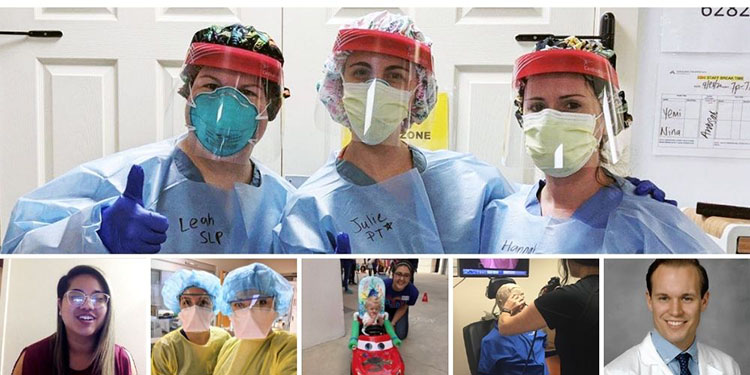
Every year, thousands of UCF grads walk off a stage with bulbs flashing and brimming with excitement as they begin the next chapter of their lives.
Thanks to the global pandemic, the last few years have included mostly metaphorical walks for the graduates. But even though COVID-19 may have waylaid their commencement celebrations, it has not deterred them from plunging headlong into careers that take them into the direct path of the virus. Take that, COVID.
But it hasn’t been easy, the alumni profiled for this story told us. Fraught with uncertainty and ever-changing information, there have been few bright spots in the lives of healthcare workers over the past two years. And although nursing and medicine professions are often highlighted in the media, CHPS alumni, who include physical therapists, social workers and speech-language pathologists, have also been in the trenches helping patients infected with SARS-COV2 – and its variants.
The six stories below share how our alumni and students are helping to save lives and help those recovering from the virus.
Jump to:
Physical Therapy Stories
Speech-Language Pathology Stories
Social Work Stories
Physical Therapy: Healing in Motion
Physical therapy is an integral part of any long-term hospital stay, but COVID care presents its own difficulties, said Patrick Pabian, director of UCF’s DPT program.
“Hospitalization due to COVID can lead to multi-system levels of impairment, ranging from muscle loss to cardiorespiratory deconditioning. All of which can lead to serious complications, let alone long-standing lack of mobility,” Pabian says. “Physical therapists play an important role in the care of a critically ill patients by providing safe and effective therapy to improve mobility and function to mitigate long-term risks of severe complications, such as pulmonary or venous embolism.”
Going Far By Going Together
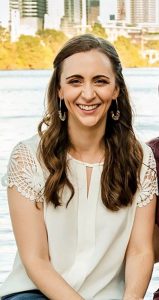
Julie Leonard Robertson ’13 ’16DPT recently co-published “The Effectiveness of Physical, Occupational, and Speech Therapy in the Treatment of Patients with COVID-19 in the Rehabilitation Setting” in the journal Global Issues in Communication Sciences and Related Disorders.
Robertson and the paper’s co-authors represented a rehabilitation team from a hospital system in Maryland. They found that rehabilitation from interdisciplinary teams of physical, occupational, and speech therapists can improve the mobility, self-care, and cognitive performance of individuals recovering from COVID-19 at the inpatient rehabilitation level of care.
“With my OT and SLP colleagues, we created this research study to demonstrate the effectiveness of rehab therapies in the treatment of COVID and emphasize the value of our services,” Robertson says. “This was a preliminary study and more research needs to be done, but we feel the results showed a significant benefit from receiving physical therapy, occupational therapy and speech-language pathology.”
Robertson, who works at Adventist Healthcare Rehabilitation in Takoma Park, Maryland, was the lead physical therapist on the first dedicated COVID-19 inpatient rehabilitation unit in the area in April 2020, and operated that unit for three months until the state set up several dedicated COVID hospitals across the state.
“Since then,” Robertson says, “I have continued to treat post-COVID patients after their infectious period has ended. These patients have been sick and isolated for so long, and often require a significant amount of rehabilitation to fully recover. Getting the opportunity to help improve their mobility and overall quality of life has been a really special experience for me.”
Having the Skills to Adapt on the Fly
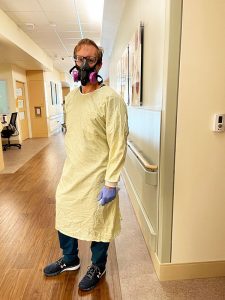
Alex Peller ’20DPT works at Advent Health Celebration in acute care, the area of the hospital that houses the most critically ill patients. At the beginning of the pandemic, he said he and the other physical therapists were uncertain how to best work with these patients. It was unknown how much physical activity they could tolerate with lower oxygen levels due to the respiratory impacts of the virus.
“Now,” Peller says, “We are a little more aggressive and try to get them up and moving as much as safely possible. There is a delicate balance between making sure they’re not lying in bed, but also not running them down.”
And while COVID-19 had not yet been discovered when he was in school, and therefore, he didn’t receive instruction specific to the virus, Peller credits the critical thinking skills that the DPT program instilled in him.
“The instructors gave me the knowledge and skills to adapt my training to similar diseases. There is a fine line between the art versus the science of physical therapy.”
In it for the Long Haul
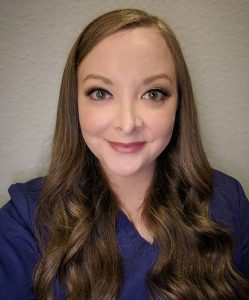
Joanna Keough ’17DPT works as a PT in the COVID unit at Orlando Health. It’s tough work.
“I try to keep a sense of humor throughout the day,” Keough says. “The other therapists and I share little jokes throughout the day to keep our spirits up.”
But some of the scenarios that Keough encounters throughout her shifts are difficult to process — like interacting with the families of her patients where she repeats the same conversations endlessly.
“Throughout the day, I’m trying to make people understand how horrible these deaths are,” Keough says. “It’s a prolonged process, and a lot of families don’t have living wills, so they have to make difficult decisions about when to switch from curative measures to palliative measures, and whether to have a DNR (do not resuscitate) order in place.”
When a patient is deemed well enough to begin physical therapy, Keough is always mindful of the ordeal the patient has been through and the long road to recovery ahead of them. Simple movement exercises that begin at bedside, like small leg and arm lifts, may be all that they are able to tolerate at first.
It’s not just the bleak outlook for critically ill COVID patients that drains on healthcare workers, but also the constantly changing protocols to keep workers safe and reduce the spread of the virus. Keough led the COVID team in her therapy unit and was responsible for ensuring everyone was following the latest guidelines.
Thankfully, more is known about the virus now and things have stabilized around policies and procedures. Now, she says, it’s not the unknown that is scary- it’s the virus itself.
“The first wave wasn’t as bad as this wave,” Keough says. “The patients we are seeing now are more acutely ill. Some therapists see the more stable patients, I see the more critically ill patients.”
Sometimes, on her drive home, Keough thinks of that likely far-off day when she can take a well-deserved vacation. Her first thought is a cruise to anywhere she can relax with her husband and not think about anything.
Surviving the Grief
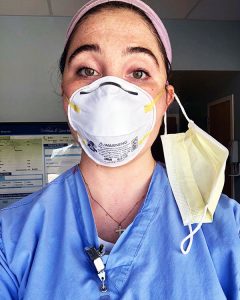
“One emotion would not describe how I feel on a daily basis in this job,” says Hannah Webster ‘20DPT.
Webster works as a PT in acute care at Tallahassee Memorial Hospital. She says she was not planning on working in acute care after graduation, and that she never could have anticipated the unique challenges she would face once the virus hit.
Webster is currently working with patients who are in the earliest phases of the virus on the hospital’s COVID unit. She helps patients make the maximum amount of safe movement to combat the adverse consequences of immobility.
“Now, we are only accepting the sickest of the sick,” Webster says. “We have over 700 acute care beds in our hospital. At this time over 125 of them are occupied by COVID patients, where before they would have been occupied by other members of our community who face life-threatening illness every day.
However, even those patients in sub-acute care with COVID have been declining rapidly and often regress back to acute care – if they make it that far.
“Some moments I am overcome with sadness for the suffering I see when we have patients who are gasping for air and ultimately require life support to continue to survive,” Webster says. “There are days I need to find a quiet space and cry to process it.”
Speech-Language Pathology: Providing Patients With a Voice
Speech-language pathologists (SLPs) working in all medical settings have found extra challenges in these COVID times, notes Gregory Lof, professor and interim director of the UCF School of Communication Sciences and Disorders.
“Communication, cognitive, and swallowing needs that are addressed by SLPs are crucial for the well being of all patients,” Lof says. “COVID has added not only the need for more services, but also the intensity of services provided. Coordinating care with other professionals always provides the best outcomes, and our graduates are adept at this collaborative approach.”
Attuned to the Struggle

Erika Daly ‘20MA, a speech-language pathologist, approaches her patients in acute care with a goal of helping them get back to their best version of themselves.
She has a list of patients assigned to her every day with varying needs; she either has evaluations or treatments and plans her day accordingly. There are different types of evaluations, such as: a thorough cranial nerve examination with assessment of speech/language/cognition, swallow assessments to determine if a patient is ready to return to oral intake versus alternate means of nutrition/hydration, or use of a speaking valve to help those with an artificial airway communicate effectively.
Daly says any fear of getting so close to a patient who has such a highly transmissible disease is offset by her dedication to her patients and her profession.
“My passion and my enthusiasm for what I do, and the care that I have for my patients, takes precedence,” Daly says.
She graduated right at the start of the pandemic and says her coursework and practica experiences gave her the knowledge to address the unique needs of these patients. She recalls a swallowing disorders course that especially captivated her, although at the time she never could have predicted how relevant that topic would become for many of her patients.
Daly knew she wanted to focus on the medical aspects of care as an SLP and was grateful when a new course, Post COVID-19 Clinical Practice in Medical Speech-Language Pathology, was initiated in the middle of the pandemic. Among the many topics addressed, it was the issue of the lingering effects of coronavirus, especially for those who had been placed on a ventilator, that caught her attention.
COVID patients may become intubated – a procedure in which a tube is placed into a person’s trachea through the mouth to make it easier to breath – or they may also have a tracheostomy, in which an opening is surgically created through the neck into the trachea to place an artificial airway. Speech-language pathologists are crucial in caring for these patients.
Many of Daly’s patients are either intubated or “trached.” Sometimes they recover, but it is never a guarantee.. Knowing the statistics prepare Daly and her co-workers for the sometimes grim outcomes that make for some emotionally difficult days in caring for these patients. But, there are also success stories. And that’s what keeps Daly going.
“A few days ago, I came home from work beaming,” Daly says. “I have been working with a patient on the COVID unit that has been here since July. When I first saw them, they were completely unresponsive.
Now, they are talking and eating full meals. To hear them tell me their name for the first time was truly remarkable. Working in acute care, I don’t get to experience that significant of a recovery often.”
Staying the Rocky Course
For most of our frontline COVID workers, working from home is not an option. Bones and muscles must be rehabilitated, speech and swallowing must be restored, people must be heard and made whole. Our clinicians do what they have to do to provide for their families and to heed their calling of caring for others, even when at risk to their own health.
It’s selfless work, done for the benefit of a stranger. But all these healthcare professionals take satisfaction in knowing that they are contributing to reuniting people with their families and restoring health in their community.


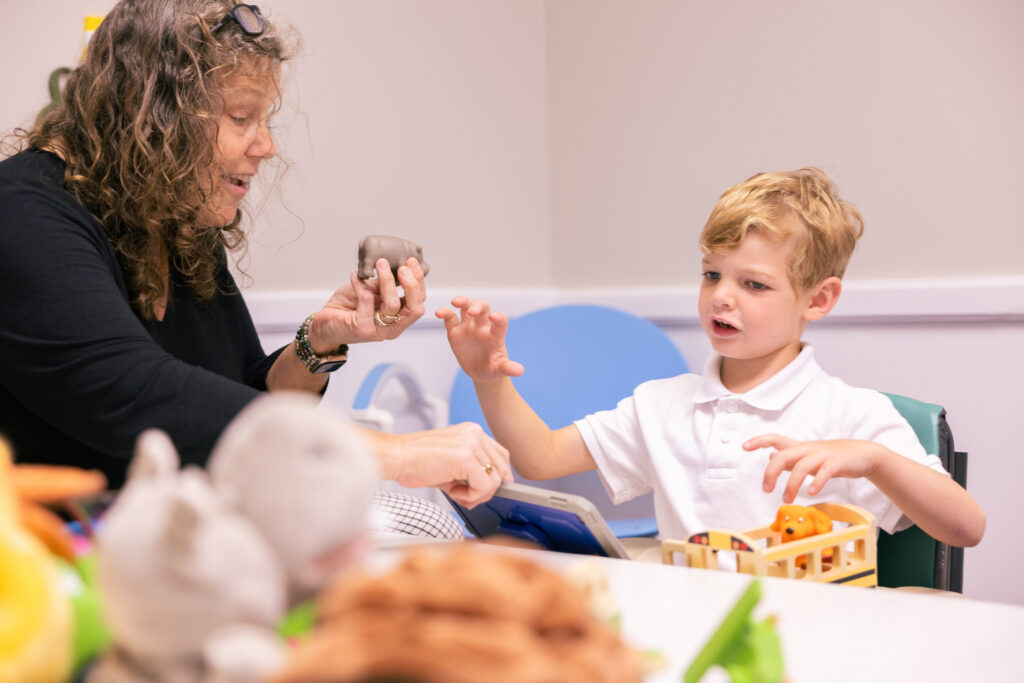

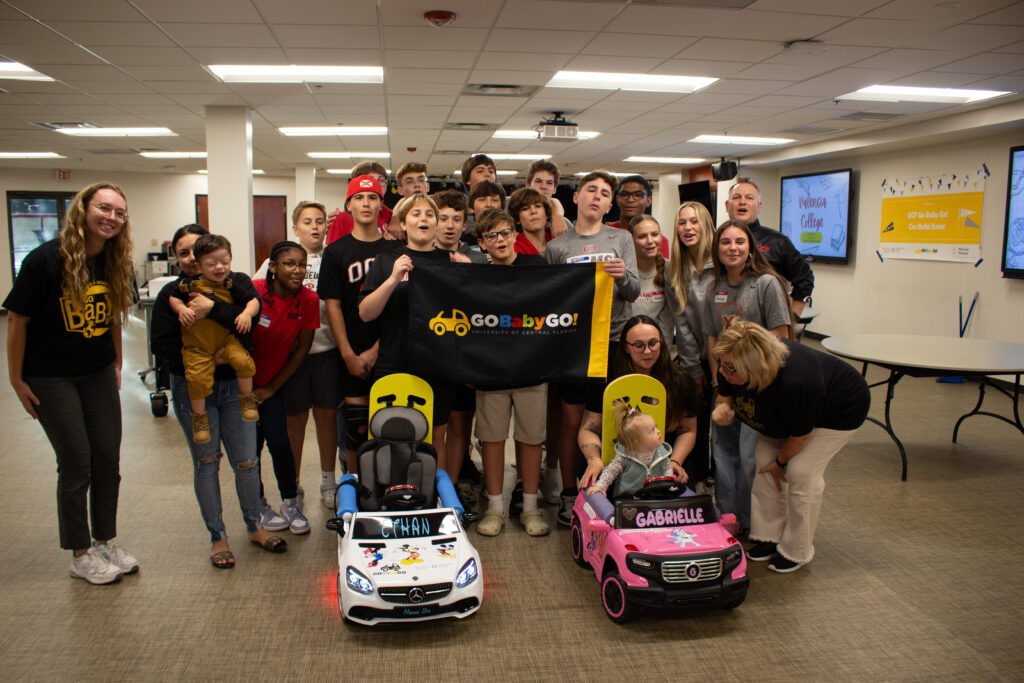
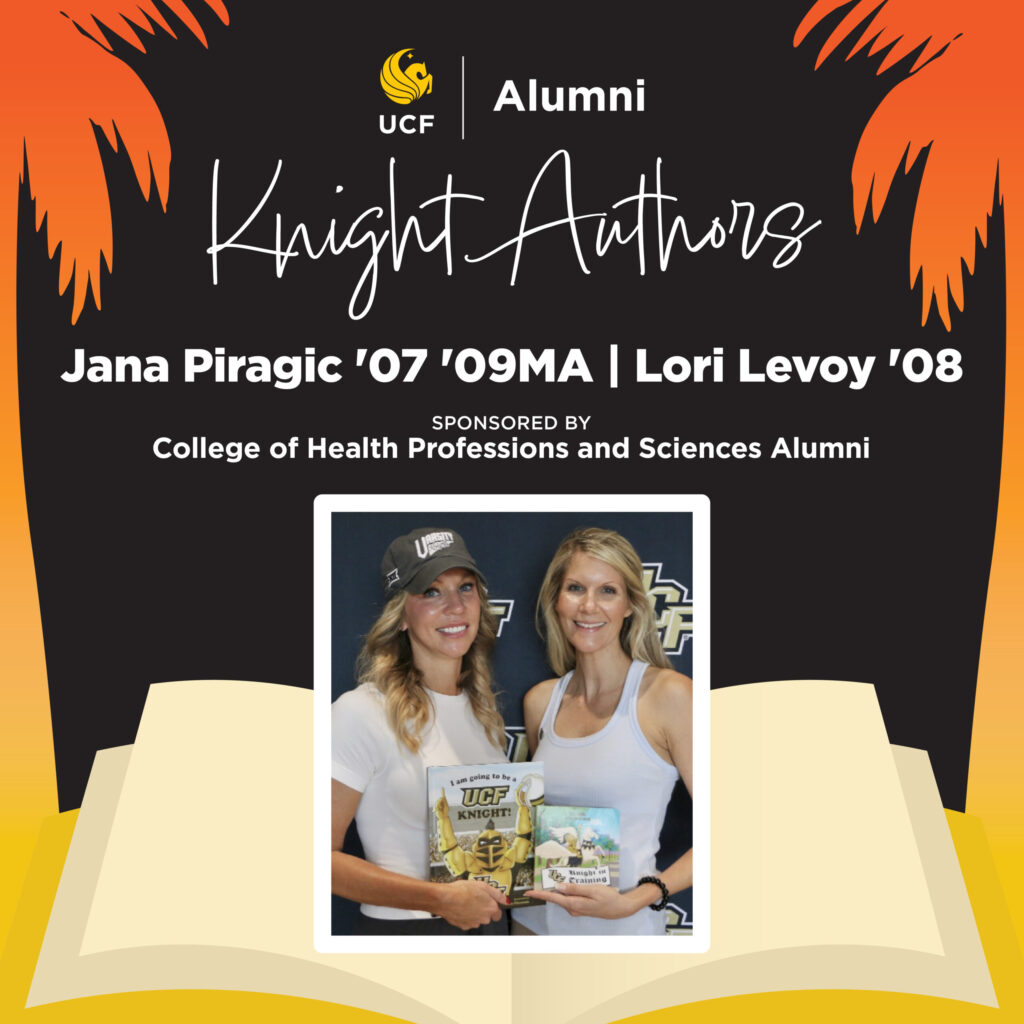


Social Work: Helping Patients Through the Darkest Days
“Social workers care for the mental, social, and emotional toll of COVID on patients and their families,” says Matthew Theriot, professor and director of the UCF School of Social Work. “Social workers are trained and ready to provide help and support at all stages of treatment and recovery from COVID, beginning with hospital social workers who help patients and families deal with the stress of hospitalization, manage complex insurance and treatment plans, and coordinate care across multiple professionals and healthcare providers.”
A social worker’s responsibilities don’t end after a patient’s discharge, Theriot adds. “Social workers also help smooth the exit from the hospital and help manage the delivery of aftercare services and appointments; they also help patients and families find solutions for financial hardships resulting from COVID and facilitate supportive community connections to aid recovery.”
Hitting the Ground Running
Christalynn Ortiz, a graduate student in UCF’s master of social work program, learned you go into a patient’s room, not exactly knowing what to expect, and you do your own assessment without preconceived ideas or judging their background.
“It’s about cultural competence, biases, micro-aggressions and preconceived notions, Ortiz says. “I am able to apply those lessons to all our patients in the nursing facility, but the best lesson that I’ve learned is to meet them where they are.”
For one of her internships, Ortiz performed intakes and assessments with new patients in the COVID unit at a nursing home in her home state of Hawaii. One of the most difficult aspects of her work was explaining to the patients why their family was not able to visit them.
Before COVID, families could come in groups, but now it’s just one person a day for a limited amount of time, and they have to go through the nursing home’s protocols for mitigating the spread of the disease.
“Many of my patients are sad because they miss their families,” Ortiz says. “It can be difficult to explain to the patients why their families aren’t coming to see them.”
Ortiz says she has a built-in network of clinicians at her internship with years of experience who help her process her thoughts and fears. Then, she gets back to work, connecting her clients to the services they need to navigate all the emotional and physical pitfalls of the virus.